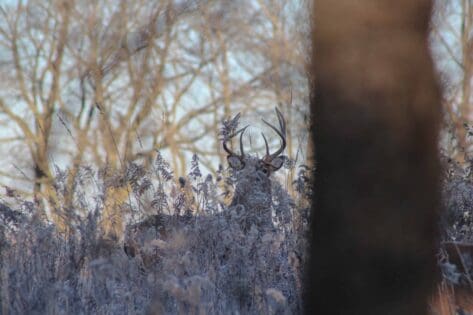 Picking that one tree out of a million others in which you will hopefully arrow a deer is perhaps one of the most frustrating and maddening aspects of deer hunting. Thoughts, strategy, and second guesses all come into play as you drive yourself mad trying to decrease the chance of anything that can go wrong will go wrong. If you are anything like me, you travel to hunt. You don’t always stick with pre-set stands, but instead bomb off into virgin territory to hunt less pressured deer. As you survey the woods and deer sign with your climber, how do you pick that one tree?
Picking that one tree out of a million others in which you will hopefully arrow a deer is perhaps one of the most frustrating and maddening aspects of deer hunting. Thoughts, strategy, and second guesses all come into play as you drive yourself mad trying to decrease the chance of anything that can go wrong will go wrong. If you are anything like me, you travel to hunt. You don’t always stick with pre-set stands, but instead bomb off into virgin territory to hunt less pressured deer. As you survey the woods and deer sign with your climber, how do you pick that one tree?
Climbers are an overlooked aspect of any hunter’s quiver of tricks. The reasons I believe are due to the extra work it takes to haul a climber up a hill, finding the right place to set up, and you really don’t see climbers being used all that much on TV. Regardless, I want to encourage you to begin thinking of using a climbing tree stand more, keeping it readily available. I can remember vividly when I began integrating a climber into my regular hunting set ups. I must have been 17 or 18. By using my climber I was able to find new and un-pressured areas. This equaled more deer sightings and close encounters.
Finding and picking the right tree can be difficult; I won’t lie to you on this. There have been many times I’ve just stood in the woods quietly trying to find any straight tree available. It can be frustrating. There have also been times I’ve had to set up on the only straight tree in the area and stick out like a sore thumb. It cost me a nice P&Y buck too. But finding any tree may not always be the safest thing either. Once, my best friend set up on a smooth bark beech tree along a well-worn trail. The problem was not in the awesome pinch point, but in the tree itself.
So, let’s say you have your area picked out. You have snuck in undetected to the general spot, now you need a tree- the tricky part.
What type of tree to look for when using climbers?
This is much more of a safety concern than anything else. Coming home safely from a hunt is the most important thing. Smooth bark allows your stand to move as you shift your weight. When picking a climber tree, look for gnarly, rough bark which your climber’s tree teeth can dig into firmly. Trees such as beech trees are soft and slippery. Take my word for it, when your stand is shifting when you are 25 feet in the air, things get scary. Avoid smooth bark trees if possible. After missing my first deer out of a climber, I sat down dejected, and the seat fell out from under me. I hit the platform grasping for the tree. Thankfully I did not fall and was wearing a safety harness.
While there are more trees than we can discuss, here are a few points on why I look for these kinds of bark in the woods.
Pine: Yes, Pine is a softwood, yet I will climb a pine tree if need be. Not only do the teeth of the climber dig well into this soft wood, the scaly and often rough textured bark keep climbers from shifting too much. The down sides to hunting in a pine are the dead branches and sap one must deal with. I’ve also found that pines often have fantastic backdrops for breaking up my outline.
Maple & Oak: While there are a variety of different Maple and Oak trees, they both remain my favorite to climb for a few simple reasons. The barks allows for little, if any shifting. Maple and Oak trees can be a pain to place screw in steps in due to its seemingly impenetrable bark. The ability of climber teeth to grab and hold bark from these trees gives you the extra security you desire while sitting 25 feet in the air. Especially with Oak trees, not only can they provide the best climbing possible, but it is no secret their acorns are like candy to whitetails.
Remember, don’t just pick any tree. Look for and pick a tree which will give you extra stability and security once you are off the ground.
Jason Reid
Last Updated: October 5th, 2022










